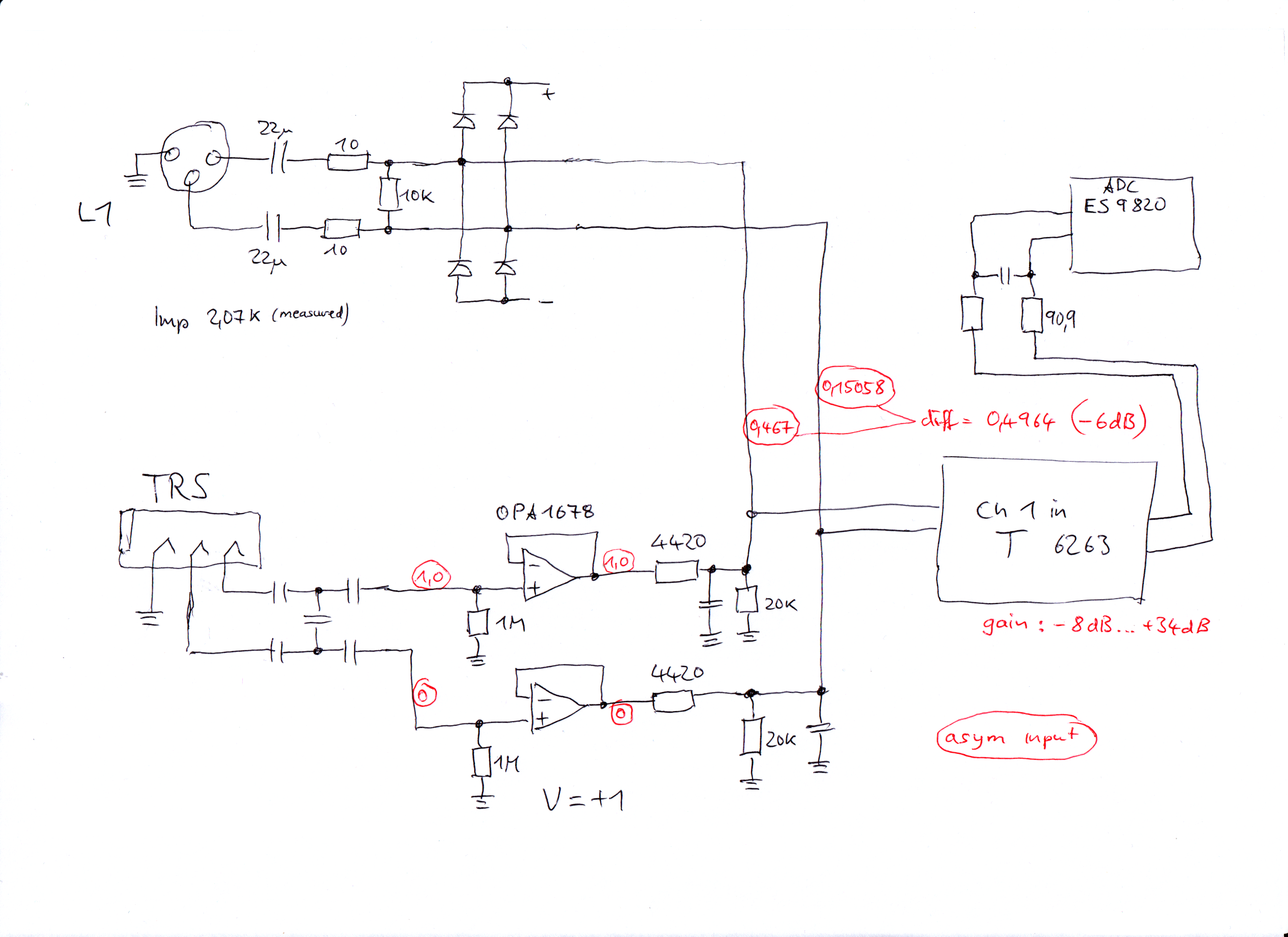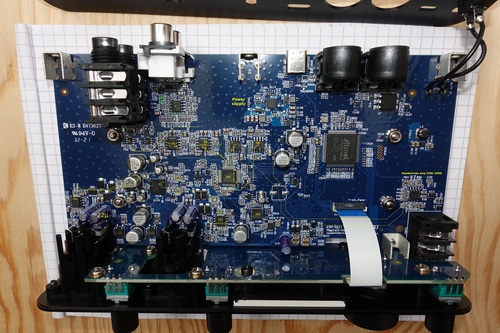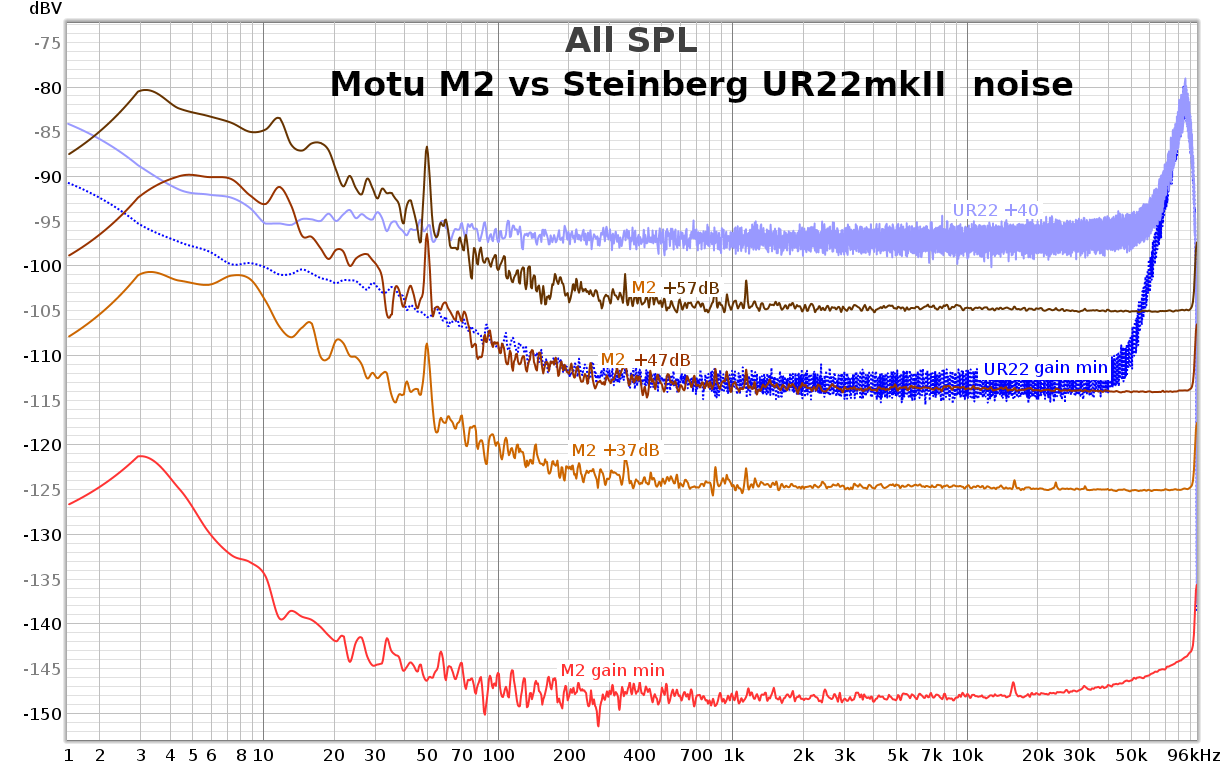The Motu M2
Version
Firmware Version 2.0.
Inputs, XLR and TRS
The signal processing is completely symmetric: both inputs in both version of TRS and XLR, the line out (TRS) is symmetric too, the used ADC and DAC are also symmetric. The only exception of course is the headphone output, which is asymmetric. That is an advantage over other devices that are only pseudo-symmetric, like for example the Steinberg UR22mkII.


The gain controls are completely digital, they generate impulses that go to the controller, which then sets the gain. This is done in a combination of two ways: Again amplifier from THAT (6263) and digital multiplication. This 6263 can set the gain only in 3 dB steps, and only inh a range of −8…+34 dB (42 dB range). To archieve the full 60 dB range with smaller steps the gain is also adjusted in digital sub-steps after the ADC, respectively before the DAC.
Noise
The noise of inputs and outputs is low, compaired to other low budget devices. The opamps are all OPA 1678 (except for the phones amp), these are FET input amps with very good input noise for a FET opamp. On places where the high input impedance is not needed, other bipolar input types like OPA 1612 would have even better input noise. But at the end the 6263 is likely the dominant noise source, so that total noise would not benefit from improved opamps. The noise spectrum is very flat, even at high frequencies close to the upper limit. Many other devices have a sharp increase of the noise above 20 kHz. Not the Motu M2.

Frequency range
The frequency response is very flat close to the upper limit of 96 kHz. On the lower end, the cut off on the inputs is just below 20 Hz, and is kind of steep. For normal audio recordings this is very good and reduces low frequent hum. For an application like subsonic measurements, this is certainly not optimum. An outstanding feature is that the line outputs are DC coupled.
Distortion
The distortion of the output is very low. The complete symmetric signal design results in very low H2 distorion, which is often the dominant portion. If inputs are used asymmetrically, the distortion is significantly higher, due to higher level of even harmonic components. The THD+N has its minimum if the gain setting is between −4 dBFS and −10 dBFS. The distortion of the used opamps, especially for high signal levels could be further reduced if the power supply was like ±18 V instead of ±5 V. But this would result in higher power consumption, and maybe in breaking the USB2 backwards compatibility. For the inputs, the major part of distortion is generated in the 6263, and is greatly dependent on the gain setting and signal level. That is the downside of a digitally controlled gain setting instead of mechanical poti.
Monitoring
Monitoring is archieved by a switch. It is effective for both input channels. Then the signal passes ADC and DAC. This causes a delay between input and output, which depends on the sampling rate: 370 µs @192 KHz sampling rate, 540 µs @96 KHz, 900 µs @48 KHz. So this is a larger delay compared to a complete analog monitoring path, but in my opinion this is a neglectable value. Even the worst value is below a milli second, which corresponds to 340 mm distance at speed of sound.
USB
The USB port is a high-speed USB 2.0 (480 Mbps) with a USB C connector. This is used for power supply. That means maximum of 500 mA at 5 V, which is 2,5W maximum.
Headphones
The phones output is made up from a OPA 1688, the output impedance is measured 0,47 Ohm @ 1kHz. The phones amp adds the signals from separate DAC outputs: one for the monitoring, one for the output.
Conclusion
A sound interface with clearly a professional design and technology inside.
